This post will explain the benefits and the downsides of having suspension (i.e. shock absorbers) on a bicycle. For ride comfort, it is also worth reading the post about the bicycle frame’s effect on comfort.
In my MTB buying guide, I wrote in more detail about bicycle suspension types and quality.
1. What is suspension on a bicycle?
Tyres filled with air (pneumatic tyres), an invention of John Boyd Dunlop, is a basic type of suspension used on practically all vehicles with wheels. Pneumatic tyres provide improved wheel traction as well as dampening of most road vibrations and shocks from road irregularities (i.e. potholes and bumps).
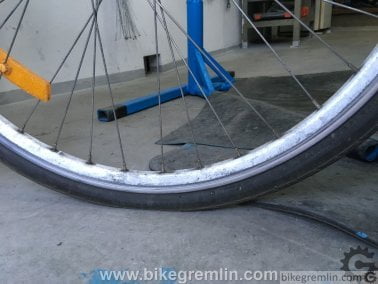
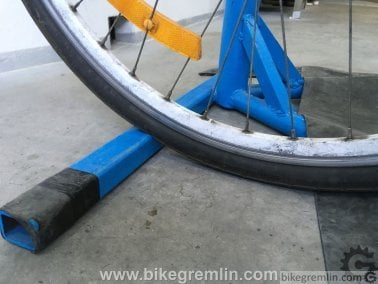
Still, the higher the speed and the rougher a road (or off-road), the greater the impacts, so tyres on their own are sometimes not enough to absorb the shocks in order to keep the ride comfortable and prevent the vehicle from jumping up and down, losing traction and control. That is where what is meant under the term “suspension” comes into play: shock absorber(s). Their job is to (additionally) dampen all the road shocks/irregularities. In cycling jargon, bicycles with front-wheel suspension only are called “hardtails“, while bicycles with both wheels suspension are called “full-sus“, or “full suspension” bikes.
2. Characteristics of (good) shock absorbers (suspension)
The function of a shock absorber is to allow the wheel(s) to follow the curves of the road, without much movement of the rest of the vehicle. Small vibrations (buzz) are still mostly dealt with by pneumatic tyres, they are still necessary for a safe and comfortable ride. A shock absorber (suspension) allows for “flattening out” larger terrain irregularities. How do they do that? By compressing and expanding. While doing that, they allow the wheels to move up and down, relative to the rest of the vehicle (bicycle frame), so the effect of potholes and bumps is highly reduced. They also have a dampening effect (more or less), so that after compression, they relatively gradually expand back to the preset position – not jumping back like a pogo. Picture 2 shows the movement range of a bicycle suspension fork. Legs can move both down (to a lesser extent) and up, from a preset position.
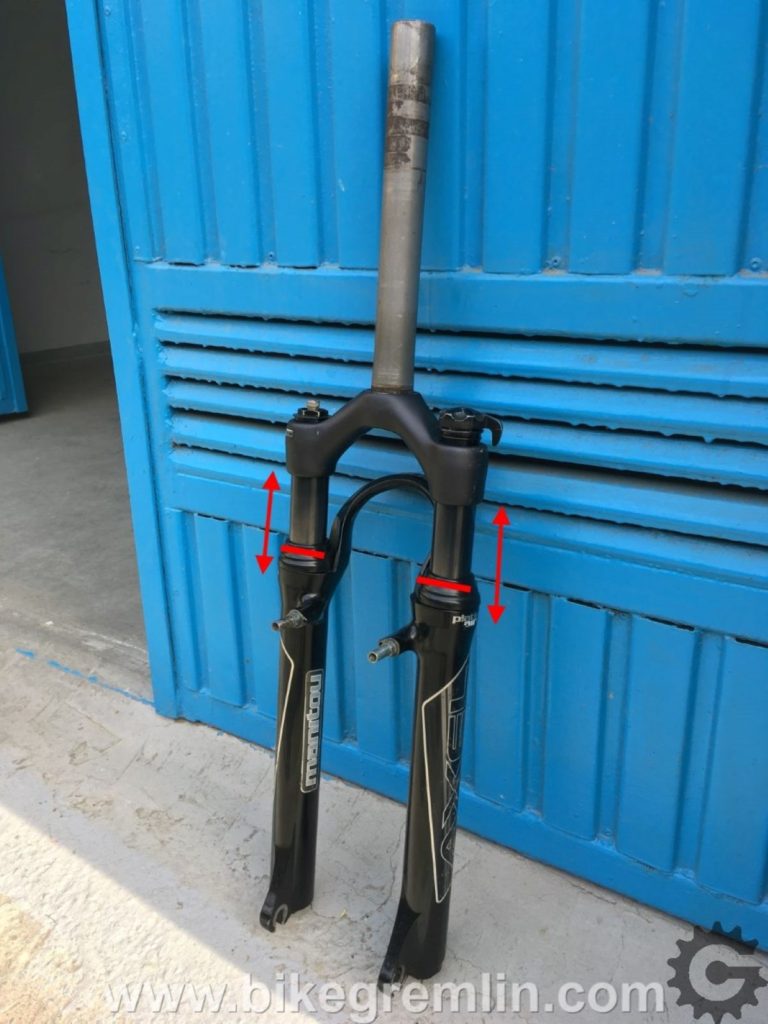
Red lines mark the part that moves, while the arrows roughly mark the movement range.
Picture 2
Features a high-quality bicycle suspension should have are the following:
- Preload adjustment – how much the suspension compresses under static rider weight – i.e. when you sit on a bike.
- Compression adjustment – how much does suspension resist compression.
- Rebound damping adjustment – how strongly and quickly the suspension extends back after being compressed.
- Low weight (i.e. mass, to be more precise).
- Good quality – durable, strong, availability of spare parts.
- Lockout option – so it can be turned off when it hampers performance (on climbs for example) – preferably via a remote control lever on the handlebars.
3. Types of suspension
In this chapter, there won’t be explanations of different designs, just the parts of a bicycle for which suspension is made. So, in short, there are suspensions for:
- The front wheel – suspension forks
- The rear wheel – rear triangle of the bike is connected to the rest of the frame via a rotating joint with a shock absorber
- Saddle – seat post with an inbuilt shock absorber
- Bars – stem with an inbuilt shock absorber
There are some other types of suspension, but they are not common (very exotic) and of questionable comfort benefits. Of the four noted, the wheel suspensions are the most important for the improvement of bicycle’s comfort and handling.
3.1. Suspension seat posts
These are a bit of a special case.
- There are (expensive) models that don’t cause (much) change in the distance from the saddle to the pedals when the suspension travels (picture 3a). Using a system of parallelograms.
- Cheap(er) ones go just up and down (telescopic system), changing the distance between the pedals and the saddle (picture 3b). This is not very good, for several reasons that are beyond the scope of this post
- There is a third kind of “special” seat post, called dropper seat post. These seat posts allow the saddle to drop by a relatively great amount, for about 15 cm, by just flipping one switch, for easier acrobatic riding 🙂 and it also allows a quick return of the saddle to the original position, for easier pedalling (picture 3c). So it’s not a suspension seat post in a classical way.
- The fourth type is a saddle with springs (picture 3d). Good quality ones have strong springs that compress only on large(r) bumps, making the ride comfortable, without making pedalling problematic by always bouncing up and down. The downside is they are rather heavy.
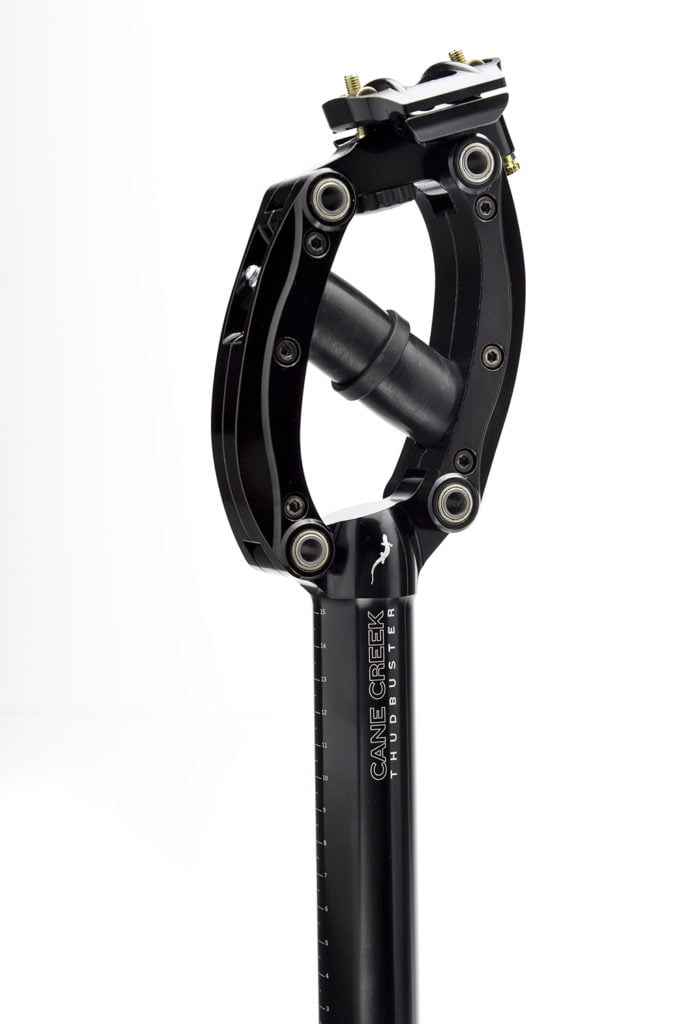
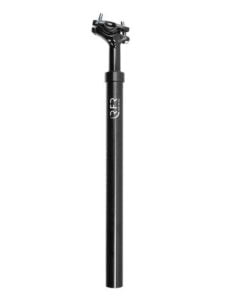
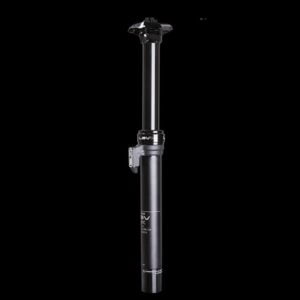
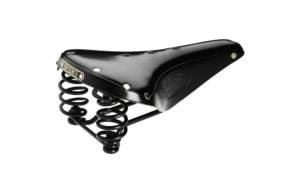
Briefly, and bluntly, to reiterate:
Good:
Parallelogram suspension seatposts (like the Cane Creek Thudbuster or Ergotec PM-705N) offer comfort without affecting your pedalling biomechanics, because they compress backwards in an arc, keeping your saddle-to-pedal distance nearly constant.
Saddles with hard, high-quality springs, like the Brooks Flyer, are also very good, but only for more upright riding positions.
Bad:
In contrast, telescopic posts compress vertically, which shortens that distance during bumps – potentially affecting your cadence or knee comfort.
4. Pros and cons of suspension on a bicycle
When explaining the pros and cons, it will be done in relation to a bicycle without suspension, i.e. “ordinary” rigid forks, seat posts and stems.
Advantages of suspension:
- More comfortable ride.
- Better control of the bicycle – better traction when cornering, even braking. This allows for faster riding on rough roads that are downhill, or flat. Of course, stem and seat post suspension mostly affects comfort (only).
Disadvantages of suspension:
- Heavier – of course, a super-expensive, super-light suspension fork, for example, might be lighter than a cheap, steel rigid one, but it will be significantly heavier than any decent quality rigid fork.
- Higher price – for similar quality level, parts with suspension cost several times more.
- Requires regular maintenance – service includes oil change, replacement of rubber seals, dust wipers etc. This costs time and money.
- Slows the bike down on climbs – high-quality suspension usually has a lock-out option, when it doesn’t slow the bike down too much, but even when locked, it’s not completely rigid, and it’s still heavier – which doesn’t help with riding up hills.
The number of noted pros and cons can be misleading. Even though there are more noted cons than pros, the important thing when choosing is one’s riding style, conditions, budget etc. For example, someone who likes to ride fast downhill on forest roads is a lot more likely to benefit from suspension than someone who rides mostly on pavement.
5. Conclusion – suspension: yes, or no?
The contents of this chapter are mostly a reflection of the author’s opinion, based on personal knowledge and experience. Is suspension a good idea, or not? It depends. For one thing, there are ways to make a bicycle decently comfortable (depending on one’s criteria) without suspension. The wheelbase is one thing that can significantly affect a bicycle’s comfort. The longer it is, especially the chainstay length, the more a bike is comfortable. Also, wider tyres do wonders when comfort and off-road traction are concerned. This is usually enough to make a bicycle comfortable for riding on paved roads and well-tred mountain paths (although, there are people who, even for city riding, find a bicycle “uncomfortable without suspension” – it is subjective).
If suspension is the choice, it is important to remember regular service and to buy good quality (and more expensive) one. Low-end suspension, without lockout and rebound damping, is a rather poor choice.
For comfort, an interesting post is also the frame’s effect on ride comfort.
Related post – Pros and cons of bicycle disc brakes (compared to rim brakes):

Author’s choice of “comfort-oriented” bicycle parts, list for online shopping links at Amazon.com (as an Amazon Associate I earn from qualifying purchases):
- Brooks Flyer – leather saddle with good, strong springs. Durable and comfortable for city and trekking bikes.
- Continental Grand Prix 4-season – 25 mm wide – comfortable road bicycle tyres with good wet road traction.
- Schwalbe Marathon Racer – comes in most sizes, from 20 to 28″ wheels. Comfortable, fast tyre for paved roads.
- Continental Race King – comfortable and fast-rolling off-road tyre, made for 26, 27.5 and 29″ wheels.
Last updated:
Originally published:

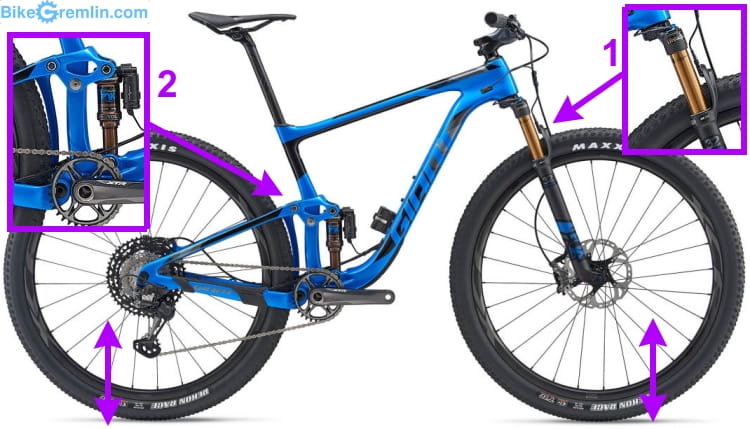
Oil change on shock absorbers? Once a year? How often.?
Thank you David
Hi David,
Manufacturers usually provide service instructions. Generally speaking:
– Every 50 hours of riding for tough, demanding conditions
– 100 riding hours for moderate off-road (not too much mud, dust, sand, or high speed descending on very rough terrain)
– Once a year for more moderate riding (pavement, or beaten paths off-road).
Relja
This is helpful and very clear. Store owners are still trying to talk me out of a hybrid with suspension forks. they’re are entry level like those on the CX 3 & Dual Sport 3. In your opinion, which do you think is better?
Thank you,
Lu
Hi Lu,
Cannondale Dual Sport 3 would be my choice before the Quick CX 3.
Regarding the suspension forks – they definitely make the most sense on mountain bikes, but many people like them on hybrid or trekking bikes as well.
If that’s your thing, go for it. 🙂